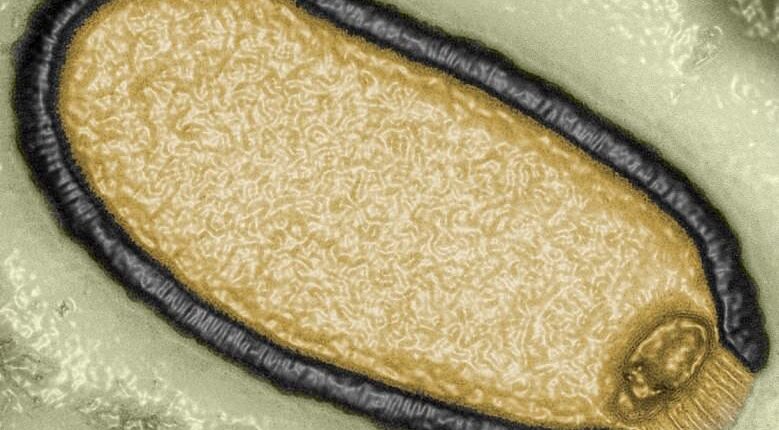Since Covid-19 brought the world to a standstill back in 2020, thoughts have turned to what the next global pandemic could be.
Many scientists are focusing their research on a hypothetical future ‘Disease X’.
But according to a new study, the answer could actually lie in the Arctic.
Scientists have warned that melting ice at the North Pole could unleash ‘zombie’ viruses with the potential to trigger a new pandemic.
These so-called ‘Methuselah microbes’ can remain dormant in the soil and the bodies of frozen animals for tens of thousands of years.
But as the climate warms and the permafrost thaws, scientists are now concerned that ancient diseases might infect humans.
Dr. Khaled Abass, a co-author from the University of Sharjah, emphasizes that climate change is responsible for more than just ice melting. It is also breaking down the natural barriers that separate ecosystems, animals, and humans.
‘Permafrost thawing could even release ancient bacteria or viruses that have been frozen for thousands of years.’

Scientists caution that the melting ice and thawing permafrost in the Arctic could potentially unleash a dangerous “zombie virus,” leading to a new global outbreak. In the image, researchers are seen traversing the thawing Greenland icecap, illustrating the impact of these changes.

Microorganisms known as “Methuselah microbes” have the ability to stay inactive in the ground and within frozen animal remains for thousands of years. Some of these ancient diseases have been successfully revived in laboratory settings. For instance, the Pithovirus sibericum shown here was recovered from a 30,000-year-old permafrost sample.

Glaciers can also store huge numbers of frozen viruses. As scientists predict that the world’s glaciers will vanish by 2100, there are concerns that these ancient pathogens could be released
For over a decade, scientists known that bacteria and viruses frozen in the Arctic could still have the potential to infect living organisms.
In 2014, scientists isolated viruses from the Siberian permafrost and showed they could still infect living cells despite being frozen for thousands of years.
Similarly, in 2023, scientists successfully revived an amoeba virus that had been frozen for 48,500 years.
However, the risks are not limited to permafrost regions, as dormant pathogens can also be found in large bodies of ice such as glaciers.
Last year, scientists found 1,700 ancient viruses lurking deep inside a glacier in western China, most of which have never been seen before.
The viruses date back as far as 41,000 years and have survived three major shifts from cold to warm climates.
While these viruses are safe so long as they remain buried in the permafrost, the big concern for climate scientists is that they may not remain that way for long.
When ice or permafrost is disturbed or melts, any microbes inside are released into the environment – many of which could be dangerous.

The bodies of frozen animals like mammoths or woolly rhinoceros (pictured) can harbour ancient organisms which survive in a dormant state. When these animals are disturbed or thaw, the microbes are released

Some of these microbes have the potential to be dangerous, such as Pacmanvirus lupus (pictured) which was found thawing from the 27,000-year-old intestines of a frozen Siberian wolf
For example, researchers discovered an ancient relative of African swine fever virus, Pacmanvirus lupus was found thawing from the 27,000-year-old intestines of frozen Siberian wolf.
Despite having been frozen since the Middle Stone Age, this virus was still capable of infecting and killing amoebas in the lab.
Scientists estimate that four sextillion – that’s four followed by 21 zeros – cells escape permafrost every year at current rates.
While researchers estimate that only one in 100 ancient pathogens could disrupt the ecosystem, the sheer volume of microbes escaping makes a dangerous incident more likely.
In 2016, for example, anthrax spores escaped from an animal carcass that had been frozen in the Siberian permafrost for 75 years, leaving dozens hospitalized and one child dead.
Yet the bigger risk is that the disease becomes established in the animal population, where increasing contact with humans makes it more likely that the disease will jump into humans as a ‘zoonotic’ disease.
According to the researchers, about three-quarters of all known human infections are zoonotic, including those found in the Arctic.
If a zoonotic disease emerged from a dormant state in the frozen Arctic, our bodies might not have the defences needed to fight an infection.

Scientists warn that pathogens from frozen animals, such as this 39,500-year-old cave bear from Siberia, could jump to modern species. If this happened, there is a serious risk of humans becoming infected by the ancient disease

The Arctic is an especially dangerous region for zoonotic diseases because health monitoring services are so limited. The researchers point out that diseases like Toxoplasma gondii are already spreading widely through people and animals in the region (illustrated)
This type of infection could lead to a particularly dangerous and hard-to-control pandemic.
Dr Abbas says: ‘Climate change and pollution are affecting both animal and human health—our research looked into how these two forces are interconnected.
‘As the Arctic warms faster than most other parts of the world, we’re seeing changes in the environment—like melting permafrost and shifting ecosystems—that could help spread infectious diseases between animals and people.’
The researchers warn that Arctic regions are an especially dangerous starting point for a pandemic since the region has so little medical infrastructure.
Health and research services are limited, meaning a disease may spread widely before the authorities have the chance to react.
Already, the researchers point out that zoonotic diseases such as Hantavirus hemorrhagic fever and the parasite Toxoplasma gondii have spread throughout the Arctic region.
However, Dr Abbas cautions that what is happening in the Arctic ‘doesn’t stay in the Arctic’.
‘The environmental stressors we studied have ripple effects that reach far beyond the polar regions.’

















